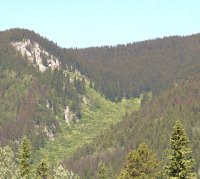2. Tree damage caused by avalanches.
3. Quaking Aspen - the world's second largest organism.
1. British Columbia is battling Mountain Pine Beetle. We saw stand after stand of dead or dying pine trees as we drove through Central BC.
 According to the Suzuki Foundation
According to the Suzuki FoundationSince 1997, mountain pine beetles have infested over 300,000 hectares of lodgepole pine forests in BC's central interior, around the cities of Prince George and Quesnel. In previous outbreaks, mountain pine beetles have killed as many as 80 million trees distributed over 450,000 hectares, making them the second most important natural disturbance agent after fire in these forests.2. Avalanches The photo below shows a swath through the trees created by one or more avalanches. There are pine trees dying from Mountain Pine Beetle infestation on both sides.
 3. Quaking Aspen (Populus tremuloides) - the world's second largest organism.
3. Quaking Aspen (Populus tremuloides) - the world's second largest organism. We saw this stand of Quaking Aspen on a mountainside when we were on our float trip. Drew told us that groves of aspen grow from a single root stock. They stand 40-70 feet in height and produce tiny cones that split to release cottony seeds that are dispersed by the winds. However, reproduction is almost exclusively by cloning - suckers sprout from the existing root system. As a result of this clonal reproduction, aspens tend to grow in pure stands. Individual ramets are relatively short-lived, but a continuous clone can be an incredibly long-lived organism.
We saw this stand of Quaking Aspen on a mountainside when we were on our float trip. Drew told us that groves of aspen grow from a single root stock. They stand 40-70 feet in height and produce tiny cones that split to release cottony seeds that are dispersed by the winds. However, reproduction is almost exclusively by cloning - suckers sprout from the existing root system. As a result of this clonal reproduction, aspens tend to grow in pure stands. Individual ramets are relatively short-lived, but a continuous clone can be an incredibly long-lived organism.Pando (The Trembling Giant), a clonal colony of single male Quaking Aspen in Utah, is currently thought to be the second largest living organism in the world. (The largest is the Great Barrier Reef.) It is also believed to be the world's oldest living being - at least 80,000 years old. The plant is estimated to weigh 6000 tons, encompasses 43 hectares (107 acres), has around 47,000 trunks which continually die and are renewed by its roots. The average age of Pando's trunks (or technically, stems) is 130 years, as deciphered by tree rings. (Wikepedia)
Some experts speculate that Pando's reign since 1992 as the heaviest and oldest organism in existence may be short-lived. Candidates for the titles include many theoretical scenarios: less well-studied Quaking Aspen in Utah that may be 80 ha in size and one million years in age, a clonal colony of at least 7 Coastal Redwood that could weigh more, possibly older fungal mats in Oregon, or older Creosote Bushes. Other scientists feel that portions of Pando's root system may be dead and might have led the plant to split into separate groups (and thus would not be one organism), though the collective groups would remain the same singular genetic individual. (Wikepedia)

3 comments:
Fascinating. I didn't know this about the Aspen.
I love trees! Thanks for increasing my knowledge about them. Quaking Aspen is such a poetic name for a tree!
Excellent pic. The beetle kill is natural but the extent is larger than it could have been if fire suppression and logging bans wouldn't have been put in place. Logging mimics a fire without killing all the critters. It's a shame we're in for some big fires in the coming years, (or months). We can intervene with your private land management in North America For info, you can email me at crtuckerco@aol.com Please use TREES as your RE:
Post a Comment